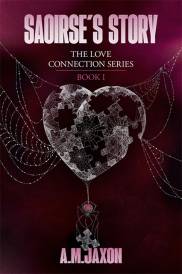Spider-Man: Into The Spider-Verse
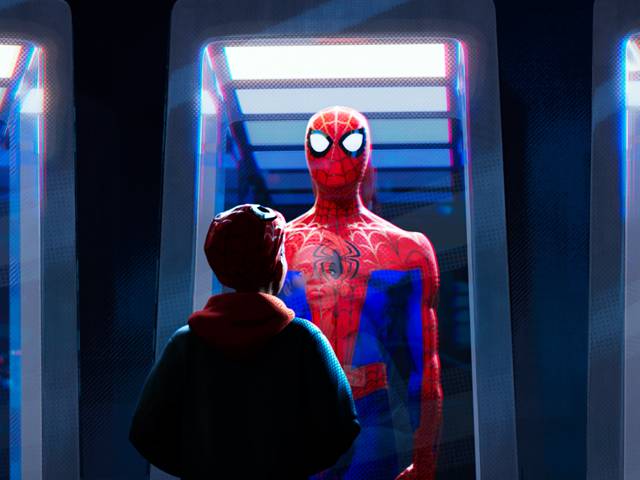
Phil Lord and Christopher Miller
Cast: Jake Johnson, Hailee Steinfeld, Shameik Moore, Liev Schreiber, Mahershala Ali, Brian Tyree Henry, Lily Tomlin
Directors: Phil Lord, Christopher Miller
Genre: Action, Animation
Rated: PG
Running Time: 117 minutes
Synopsis: Phil Lord and Christopher Miller, the creative minds behind The Lego Movie and 21 Jump Street, bring their unique talents to a fresh vision of a different Spider-Man Universe, with a groundbreaking visual style that's the first of its kind. Spider-Man: Into the Spider-Verse introduces Brooklyn teen Miles Morales, and the limitless possibilities of the Spider-Verse, where more than one can wear the mask
Spider-Man: Into The Spider-Verse
Release Date: December 13th, 2018
About the Production
A New Spidey Comes To Life
Spider-Man: Into the Spider-Verse allowed award-winning and prolific producer Avi Arad the chance to revisit his animation roots. Arad, who has had a long successful career producing both animated and live-action TV series and movies " including the six previous Spider-Man features " recalls, "Everyone was going from animation to live-action, and we thought we should do it the other way. We had the chance to showcase the style and art of the amazing comic-books and make a movie for all ages. The idea of diversity was also very important to us, because the big theme of Spider-Man is that anybody can be under that mask. What the mask says is that when you put it on, you have the heart and soul of a hero." Producer Amy Pascal (SpiderMan: Homecoming, The Post) points out that the movie allowed the filmmakers to approach the familiar superhero from a fresh new angle. "Avi and I both agreed that there had never been an animated movie about an established comic-book superhero," recalls Pascal. "We wanted to produce a highly original animated feature that was made for everyone, not just for kids. Animation offers us a whole new way to explore the characters and in ways that we couldn't do in live-action movies before."
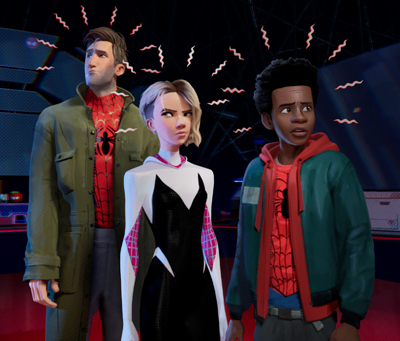 "We are all lucky to have been able to work on this phenomenal property that has such a huge audience invested in it," says director Bob Persichetti (writer and head of story on The Little Prince and Puss in Boots). "That's why we could be bolder with our visual choices. Our goal was to expand the visual style and color palettes and deliver a movie that might seem different than any of the other CGanimated movies we have seen in the past. One of the strengths of the comic is that it manages to encapsulate in one image a really succinct, powerful story point, motion, or action. In our process of animation, we tried to achieve that same thing."
"We are all lucky to have been able to work on this phenomenal property that has such a huge audience invested in it," says director Bob Persichetti (writer and head of story on The Little Prince and Puss in Boots). "That's why we could be bolder with our visual choices. Our goal was to expand the visual style and color palettes and deliver a movie that might seem different than any of the other CGanimated movies we have seen in the past. One of the strengths of the comic is that it manages to encapsulate in one image a really succinct, powerful story point, motion, or action. In our process of animation, we tried to achieve that same thing."
Led by the directors, the artists and visual effects team at Sony Pictures Imageworks experimented with a dazzling visual style that pays homage to the look of vintage comic-books. As director Peter Ramsey (Rise of the Guardians) explains, "Of course, dozens of Marvel movies lean on that look while telling a cinematic story, but I can't think of any other animated film that make this much of a visual statement. That's why audiences have had such a great reaction to the film's original trailer and clips so far."
Ramsey, who is one of the top African American directors working in animation today, says it has been especially rewarding to work on a film centered on a superhero that comes from a diverse background. "Until recently, the scarcity of heroes and lead characters that are not white has always been a bit of a subtle mental stumbling block for people of color," he shares. "I believe that the introduction of Miles Morales as Spider-Man sparked a renaissance and a trend to reimagine and feature characters that are not white and not male. That's the story we set out to tell."
For director and co-writer Rodney Rothman (writer on 22 Jump Street), the movie has a lot in common with a meticulously crafted, epic live-action project. "Every frame had to be carefully crafted," he explains. "Our general approach was to push every aspect of the movie as far as we possibly could; we aimed to create something that felt completely new to the audience. In terms of story, just like the original graphic novel, it's all about Miles Morales' story, his family and their relationship. We have all these exciting elements of a superhero movie and the various characters and various possibilities of the Multi-Verse, but the heart of the movie is all about Miles' relationship with his family."
Producer Christina Steinberg (The Bee Movie, Rise of the Guardians) says she believes that Spider-Man is the most relatable of all the superheroes. "We've always held up the idea that Phil [Lord] infused in his first draft of the script " that anyone can be behind the mask " as a theme for our movie. Anyone in the audience can imagine that they too can become a superhero and truly make a difference. It is a choice to be a hero, but we all have it in us if we accept the challenge!"
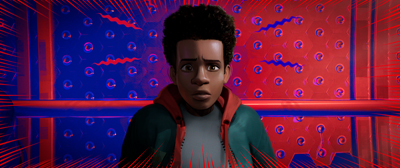 Casting A Wide Web Of Vocal Talent
Casting A Wide Web Of Vocal Talent To voice the colorful characters of Spider-Man's new adventure, the filmmakers tapped some of the brightest and most talented actors working in Hollywood today. Providing the film's main voices are Shameik Moore as Miles Morales, Jake Johnson as Peter Parker, Hailee Steinfeld as Spider-Gwen, Mahershala Ali as Miles' Uncle Aaron, Brian Tyree Henry as Miles' father Jefferson, Lily Tomlin as Aunt May, Luna Lauren Velez as Miles' mother Rio, John Mulaney as Spider-Ham, Kimiko Glenn as Peni Parker, with Nicolas Cage as Spider-Man Noir, and Liev Schreiber as Kingpin.
Shameik Moore (Dope, The Get Down) voices Miles Morales, a young teenager and a Brooklyn native who is thrust into a new school. But he's having an even harder time adjusting to his entirely new and unexpected life as a Spider-Man. After meeting some other versions of the superhero from parallel universes, Miles learns to unlock the hero inside himself.
"I am a big fan of the Spider-Man films," says Moore. "In fact, when I was a teenager, I wrote in my diary that one day I would play Spider-Man! But Spider-Verse goes beyond everything we've seen before with the multiple universes, multiple villains and multiple spider heroes. With Miles Morales you have a Spider-Man character that we've never seen before on the big screen. It's a completely new experience. It's also important to point out that Spider-Verse is the first movie about a biracial superhero, ever.
His culture, background and upbringing really makes him a different type of superhero " something we have all been eager to see on the big screen for a very long time. That's why I'm very proud be a part of that. "
"They have really sauced things up with this movie," Moore adds, "I think both the fans of the original old-school Peter Parker Spider-Man and the new Miles Morales character are going to love this movie. Miles is young, bright and confident, and he's very different from Peter. But they both have to deal with the responsibilities and rewards of being Spider-Man. They also have different powers. Audiences are also going to really love the story, and enjoy the beautiful animation."
 Actor Jake Johnson (New Girl, BoJack Horseman) lends his vocal talents to the role of Peter Parker, an older version of Spider-Man. He may look like Peter, but he is older, and the years of superhero life have taken a toll on his body. His experiences have left him world-weary and cynical. Peter never wanted to be a mentor, but training Miles Morales to be Spider-Man helps him to regain his original enthusiasm for that identity and reclaim the spirit of selflessness for which SpiderMan stands.
Actor Jake Johnson (New Girl, BoJack Horseman) lends his vocal talents to the role of Peter Parker, an older version of Spider-Man. He may look like Peter, but he is older, and the years of superhero life have taken a toll on his body. His experiences have left him world-weary and cynical. Peter never wanted to be a mentor, but training Miles Morales to be Spider-Man helps him to regain his original enthusiasm for that identity and reclaim the spirit of selflessness for which SpiderMan stands. "I am a big fan of Peter Parker and love the Spider-Man world, but I thought this movie had a very original take on the superhero universe," says Johnson. "Peter is now a 40-year-old guy who has had to watch his life fall on the wayside because he's Spider-Man. The Peter Parker I play wears the familiar red and blue costume of the classic Spider-Man we all know and love. However, this Peter Parker is a bit older, more weary and full-bodied version of the character…He's definitely a strong hero but his many years of saving the world have had an impact on him. You might say that the Spider-Verse Peter Parker is a more seasoned and relatable version of Spider-Man."
Johnson mentions that one of the projects biggest draws for him was working with Phil Lord and Chris Miller. "They are two of the most talented filmmakers working in the field right now. They are so innovative and smart, and when they tackle something like Spider-Man, you know they're going to get it right. This is a property that fans really love, so you want to make sure it's in the hands of people who also love and care about it as much as the fans do." To voice the pivotal role of SpiderGwen, a super-cool SpiderWoman, the filmmakers relied on the talents of Oscar®-nominated actress and singer Hailee Steinfeld (True Grit, Pitch Perfect 2, Bumblebee). An intelligent and quick-witted teenager, Spider-Gwen is the Spider-Woman of her world, an excellent fighter who can swing and flip with the grace of a trained dancer. Although tough and brave when she's fighting the bad guys, Gwen has suffered a loss in her universe that's made her afraid to get close to people, even to an open-hearted kid like Miles. Once she learns there are others like her, she has the opportunity to let down her guard and become part of a team who have overcome their own tragedies to become the protectors of their worlds.
"I enjoyed playing Spider-Gwen because she's really just the toughest, coolest, smartest and the most capable one in the room, and she knows it," says Steinfeld. "Working with the directors has been an amazing experience, since this was the first time I was doing such an extensive amount of voiceover work. I love the collaborative nature of animation, where the visuals are being created in real time during the voiceover. It was also fun to play with Spider- Gwen's secret identity and work on her voice when the natural leader just kicks in and she becomes a superhero."
 Oscar®-winning actor Mahershala Ali voices Uncle Aaron, Miles' fun uncle who understands him the most. Aaron and his brother Jefferson grew up in rough circles and found themselves in a life of petty crime. When Jefferson started a family, he walked away from his criminal life and hoped that Aaron would do the same, but Aaron still lives a life of which Jefferson disapproves. Miles loves his uncle and finds refuge with him when he feels overwhelmed by his new school. Aaron encourages Miles as an artist but also as a truant, and Miles is inevitably drawn to his uncle's more free-wheeling style than to the tough love he encounters at home.
Oscar®-winning actor Mahershala Ali voices Uncle Aaron, Miles' fun uncle who understands him the most. Aaron and his brother Jefferson grew up in rough circles and found themselves in a life of petty crime. When Jefferson started a family, he walked away from his criminal life and hoped that Aaron would do the same, but Aaron still lives a life of which Jefferson disapproves. Miles loves his uncle and finds refuge with him when he feels overwhelmed by his new school. Aaron encourages Miles as an artist but also as a truant, and Miles is inevitably drawn to his uncle's more free-wheeling style than to the tough love he encounters at home. "I really enjoyed voicing Uncle Aaron in Spider-verse," says Ali. "I think he is one of the more complex and fascinating characters I have come across in both comic-books and animated movies in general. His relationship with Miles is one of the major emotional components of the film, and I think fans of the comic-book are going to be very pleased with how the filmmakers have developed this interesting figure in the movie."
Acclaimed actor Brian Tyree Henry (Atlanta, If Beale Street Could Talk) voices Jefferson Davis, Miles' strict but loving dad and super cop. "When Jefferson was growing up, he lived the life of a petty criminal," says Henry. "But when he met his wife, Rio, he left the criminal world behind, becoming a police officer and adopting a strict moral code. He's proud that Miles has been accepted at the prestigious Brooklyn Visions Academy and is determined that his son will do well and not repeat the mistakes of his own youth."
He adds, "Jefferson and his brother Aaron used to be real tight at one time and might even have gotten into a little trouble back in the day, but a guy who follows the rules and a guy who breaks the rules will always have a little tension."
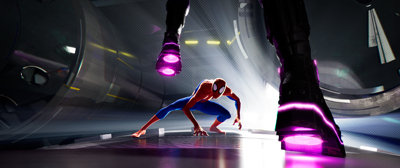 Henry says it's important that Miles is presented as a culmination of many cultures. "Miles Morales is an African American, like his dad Jefferson, but he's also Puerto Rican like his mother Rio. Like a lot of people Miles isn't just one thing or another but the culmination of many cultures. Miles Morales is a hero to all people who don't identify as one race or another. Miles is a combination of two proud cultures that created one multi-faceted individual."
Henry says it's important that Miles is presented as a culmination of many cultures. "Miles Morales is an African American, like his dad Jefferson, but he's also Puerto Rican like his mother Rio. Like a lot of people Miles isn't just one thing or another but the culmination of many cultures. Miles Morales is a hero to all people who don't identify as one race or another. Miles is a combination of two proud cultures that created one multi-faceted individual." The role of Rio Morales, Miles' loving mom and most sympathetic supporter is played by Luna Lauren Velez. Rio is a strong and encouraging presence in Miles' life whose support helps Miles keep his head above water when he feels overwhelmed by school or by his Spider-Man challenges. Hailing from Puerto Rico, she fosters a special bond with Miles by speaking Spanish with him. Rio has no idea that her son has become a Spider-Man or that he's trying to do his school work while saving Brooklyn from destruction.
"I loved playing Miles' mom in the movie," says Lauren Velez. "I think it's very important for audiences to see characters who look like them and sound like them in animated movies. Rio is a positive, supportive figure in her son's life. She's always there for him, and is able to offer her love, warmth and encouragement to Miles whenever he needs it most. Rio is a loving mother, a proud bilingual Puerto Rican and a career woman who juggles her family responsibilities with her passion for being a nurse."
What would a Spider-Man adventure be without Aunt May? The producers were fortunate to have none other than Oscar®- nominated actress Lily Tomlin (Nashville, Nine to Five, Grace and Frankie) voice the character. Seen as the pillar for all Spider-People, Aunt May has been very involved in her nephew's Spider-Man world, creating gadgets and providing tactical support for his superhero adventures. When May learns that there are Spider-People from other universes who need her help, she's ready to provide coffee and web-shooters. She even wields a baseball bat to fight alongside them when the villains arrive.
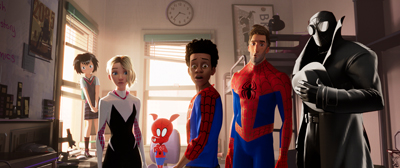 "We were actually thinking of Lily Tomlin as we were writing the script," recalls Lord. "So, we were thrilled when she said yes to playing the role. This version of Aunt May is kick-ass and feisty. She can definitely hold her own amongst the other crimefighters. Plus, she has this natural warmth and support for Miles. That's why we think Lily was such a natural for the role. Who doesn't want to have a character like that batting for them?"
"We were actually thinking of Lily Tomlin as we were writing the script," recalls Lord. "So, we were thrilled when she said yes to playing the role. This version of Aunt May is kick-ass and feisty. She can definitely hold her own amongst the other crimefighters. Plus, she has this natural warmth and support for Miles. That's why we think Lily was such a natural for the role. Who doesn't want to have a character like that batting for them?" Voicing the role of Spider-Man Noir is Oscar®-winning actor Nicolas Cage (Moonstruck, Leaving Las Vegas, Adaptation). "He is from a dimension that is literally black and white," explains Cage. "Spider-Man Noir is hard boiled, he's probably the edgiest of the Spider-Men" think Raymond Chandler, Paul Cain, those great old detective novels. He's a 1933-era private eye and he's fighting Nazis, so he's a real hero."
The actor says he enjoyed voicing Spider-Man Noir because the directors allowed him to have fun with the role and to pay homage to some of his favorite classic actors, such as Humphrey Bogart and James Cagney. He explains, "I felt like we were doing something new and something original with the character. In addition, the movie is really about positive qualities like being heroes and doing the right thing for the community. It's also great for families, because everyone is represented. I can also tell you it has a terrific sense of humor."
Cage says to him Spider-Man is one of the most iconic comicbook characters and the ultimate superhero. "He is the most highly watchable action character with a great sense of humor. I think Stan Lee also felt that Spider-Man is one of his greatest achievements. And it's no secret that I like to play with different sources. It was fun to go back in time and pull back a little of that Humphrey Bogart essence. I think it will be interesting for young people because they may watch the movie and want to learn more about this Humphrey Bogart character"let me check out his movie Casablanca and find out! So, I think there's something in this for everyone, for the adults who like the old movies like I do, and also for the kids or the young people who will want to learn more about them."
Every great superhero movie needs a diabolical, scary supervillain. Spider-Verse has its share of classic Spider-Man villains, but none is quite as frightening as crime boss Kingpin, voiced by acclaimed actor Liev Schreiber (Ray Donovan, Spotlight). "One of the great things about the movie is that it has a lot of villains," he says. "Of course, I'm in control of all of them, so that's even better." Schreiber says his character is motivated by the loss of his family.
 "He caused them a lot of shame the first time he went after Spider-Man, so he hopes to use the nuclear supercollider to bring his family back. He doesn't care what havoc that wreaks on the rest of the planet."
"He caused them a lot of shame the first time he went after Spider-Man, so he hopes to use the nuclear supercollider to bring his family back. He doesn't care what havoc that wreaks on the rest of the planet." Producer Phil Lord says Kingpin is one of his favorite characters because he seems to eclipse every one of the frames that he happens to be in. "His physical presence doesn't leave room for anything else. He can just stand there, and everything bends to his will, even the camera. He is basically this pure black figure and the most abstracted animated characters I've ever seen." Peni Parker is another one of the Spider-Verse's unexpected delights. This anime Spidey heroine hails from a future version of Earth. Orphaned at a young age, Peni was raised by her uncle Ben and aunt May, but she carries on her father's legacy by operating the SP//dr Mecha suit abandoned by her father years ago. The suit's head is also the home of a radioactive spider that shares a psychic link with the pilot. "One of the coolest things about Peni Parker is that you wouldn't expect this tiny, happy and energetic young girl to be the heroic pilot of this hulking super bot," says Kimiko Glenn (Orange Is the New Black, BoJack Horseman), who voices Peni. "There's this great part of her character that plays with the idea that looks can be deceiving." Glenn also points out that what really makes the movie break new ground is its representation of the diverse world in which we all live. "There are Spider-men and Spider-women on this team of heroes, which is really cool. Miles Morales is an African-American and Puerto Rican, and my character, Peni Parker, is a strong Asian-American hero. The real world is made up of all different kinds of people, and that's also true in the Spider-Verse."
John Mulaney, two-time Emmywinning comedian brings a lot of slapstick humor to the role of Spider-Ham, a superhero who would easily feel at home in the classic toons of the '40s and '50s. Spider-Ham was first introduced in Marvel comics by creators Tom DeFalco and Mark Armstrong in 1983. This version of the character allowed the artists to have a lot of fun with rubber-hose style animation and visuals that are loose and graphic and stand out from the other figures in Miles' universe. Spider-Ham follows the rules of his own animated universe and can even throw a black circle on a wall and climb right through it.
As producer Phil Lord points out, "We just followed the possibilities that are inherent in the concept, but we also do stuff that we're usually not allowed to. We have an anime character interacting with Spider-Ham, who is something from a slapstick cartoon, next to a black-andwhite character. You think to yourself, 'Wow, we're breaking all the rules. That level of fun and freedom gave everyone on the film a lot of room to play with.
"I never thought I would get to play an anthropomorhic character called Peter Porker/SpiderHam," says Mulaney. "As a comic, I'm a huge fan of classic cartoons, and this role allowed me to have a lot of fun with a totally off-the-wall character, who adds a lot of good laughs to the movie. The directors really allowed to us to have a blast as we did the voices for the movie. You can say I was encouraged to really ham it up!"
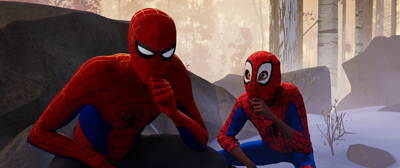 A Visual Feast
A Visual Feast Helping the producers and directors realize their vision for the new superhero was production designer Justin K. Thompson, whose many credits include TV shows such as Samurai Jack and Star Wars: Clone Wars. He also collaborated with Lord and Miller on the two Cloudy with a Chance of Meatballs movies.
"I looked at the early development art that had been created for the movie and felt that while they were quite beautiful, we could really go farther and explore the comic-book language more," says Thompson. "I learned how to draw by emulating the art work I loved in comics, and Spider-Man was a character that I loved from an early age. That's why I was really excited when Chris and Phil told me, 'What if you were given carte blanche and could make an animated movie based on a comic-book?'"
Thompson says what most movies often get wrong is how super slick and glossy their comicbook universes look. "Comic-books are actually quite gritty in the way they're made," he points out. "One of the things that appealed to me as a young boy was that I felt as if they gave me a window though a mysterious, darker world. The superheroes were dealing with the same problems that I was dealing with, but the stakes were much higher. Miles' actions lead to the death of someone very dear to him and we didn't want to downplay it. We didn't want to shortchange that and turn this into a family film where everything is brightly lit and cheerful."
The technical wizards at Sony Pictures Imageworks set out to recreate the tactile, granular feeling of a graphic novels, even going as far as recreating the dot-printing process used in older comic-books. "You really feel the artistry as you turned the page," recalls Thompson. "I know that one thing the computer does really well is realism. What we wanted to do was to invent our own reality, and then bend all the rules."
Thompson points out the result of their work is a completely fresh movie that combines CG animation and hand drawn techniques and looks like nothing audiences have seen in the past. In fact, each frame of the movie took four times as long to make than a frame of a typical animated movie. "Our goal was to break the traditional CG rules where everything is exact, photo-real and perfect," he notes. "We wanted to invent our own unique visual language, rich with its own stylistic elements, color palette and shapes " a world where you can definitely notice the choices made by the artists in every frame."
As art director Dean Gordon, who also worked on the two Cloudy movies with Lord and Miller, explains, "The nature of technology of CG tends to fight a graphic look. We made hand-painted textures, with a level of abstraction to them, that we mapped onto geometry to get a more illustrative feel to our world. We did not want photorealism. We broke down gradations and color values into areas and created shorter transitions between them to get a more illustrative feel in the scenes. We brought the same ideas for the characters' skin tones. Having the skin tones fit in the same environment and use the same screentones and hatchings we see in comics elevated that comic book look."
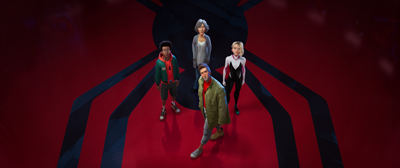 Another way to get the comicbook feel was to play with the lighting of scenes throughout the movie. "There has always been this tendency in animated movies to go all in on bright, vibrant lighting," says art director Patrick O'Keefe. "We looked at a lot of different kinds of photography and paid careful attention to the happy accidents of shooting with a real camera, the way shadows group or how light bleeds into the edges of the film. For this film, we push ourselves to go as dark as the sequence needed to be. A character might be in a black silhouette with just rim lighting. We used dark shapes, with just glimpses of light to describe them. It really extended the range of what we could and did put up on the screen."
Another way to get the comicbook feel was to play with the lighting of scenes throughout the movie. "There has always been this tendency in animated movies to go all in on bright, vibrant lighting," says art director Patrick O'Keefe. "We looked at a lot of different kinds of photography and paid careful attention to the happy accidents of shooting with a real camera, the way shadows group or how light bleeds into the edges of the film. For this film, we push ourselves to go as dark as the sequence needed to be. A character might be in a black silhouette with just rim lighting. We used dark shapes, with just glimpses of light to describe them. It really extended the range of what we could and did put up on the screen." Head of Character Animation Josh Beveridge, an alum of many movies at Sony"including Open Season, Surf's Up, Cloudy 1 and 2, Arthur Christmas and Hotel Transylvania 1 and 2"points out, "Our big challenge was creating that balance between being cartoony and realistic," he notes. "To deliver the best representation of comic books to animated life, we had to break and overhaul our way of looking at things. It led us to frame modulation to get this slick, crispy version of pop art. When we make Spider-Man in live action, its hard to put Spider-Man in these fantastic comic book poses because we had to deal with the real physics to put him in these fantastic poses. But animation allows us to break physics. To make it feel right without having to be limited by the restraints of reality. We worked hard to get the animation on 2s (meaning 12 frames per second instead of 24), to work both with simulations and complex camera moves. We don't want to be too choppy and not too smooth. You want crisp pop with aggressive clarity. At Sony Pictures Imageworks, we have an amazing robust pipeline, and I think we have forever altered our pipeline thanks to this project."
Exploring The Possibilities Of Animation
Head of Story Paul Watling (Hotel Transylvania 2, Smurfs: The Lost Village) says animation allowed the film to have many advantages over the live-action versions of the franchise. "We would really push the visuals in ways that live-action just can't," he points out. "There's a sequence in the movie where Miles and Peter are involved in this above-ground train chase, where one character is attached to the other. It was a story artist's dream because we were given an empty sandbox and allowed to build the coolest sand castle. The filmmakers weren't pulling any punches. They kept encouraging us to go further, and we pushed ourselves as much as possible. We threw everything we could possibly could at them, in terms of camera angles, moving frames, comedic elements, police cars hot on their trail to add this sense of urgency" as well as slapstick elements added on. I don't think we've ever seen Spider-Man like this before."
For story artist Miguel B. Jiron, the film was a chance to play in a comic-book world he had loved as a kid. "The movie allowed us to incorporate panelization, action lines, visual sound effects," he notes. "But even more than that, I was really honored to be part of this team to bring Miles Morales into cinematic life. As a first-generation immigrant, it's very meaningful to me to see characters like Miles out there " not only being a hero, but being Spider-Man. I'm so honored to have been able to explore and play with this character."
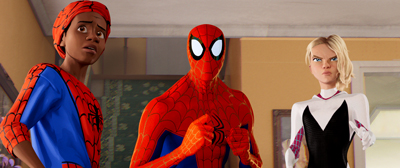 Jiron mentions that with all the film's creative elements, ideas and characters, it was always helpful to remind himself to bring everything back to Miles. "It was key to ground all the craziness with this unique perspective of a 13-year-old who can't quite believe his destiny and finds himself greater than he could ever imagine."
Jiron mentions that with all the film's creative elements, ideas and characters, it was always helpful to remind himself to bring everything back to Miles. "It was key to ground all the craziness with this unique perspective of a 13-year-old who can't quite believe his destiny and finds himself greater than he could ever imagine." Imageworks veteran Danny Dimian, who is Into the Spider-Verse's visual effects supervisor, sees the film's creative journey as a natural evolution of what the studio has been able to achieve over the past two decades. "This return to Spider-man reminds me of our work on The Hollow Man (2000)," says Dimian. "Back then, what we were trying to do wasn't achievable with readily available software and techniques, so we had to rethink everything and write new tools. This time, though, we are not just writing the software from scratch. We are trying to find a new visual comic book language to tell super hero stories."
Dimian "whose many credits include the 2002 Spider-Man, Stuart Little 2, The Polar Express, Surf's Up and Cloudy with a Chance of Meatballs " says the Imageworks team tried to stray away from the rigid formality associated with CG animation. "Computers do everything correctly and so you always have the right perspective and geometry all the time," he points out. "What's interesting and expressive about art is all the imperfections that go hand in hand with a human creating things. We had to find a way to break things and allow the hand of the artist to show through. Design and emotion took priority over accuracy and realism.
Among the many stylistic ways the Imageworks team paid homage to old comic-books was emulating the imperfections of color offsets. "We noticed that sometimes in printing comic books, the color offsets were not aligned properly and this looked like the image was out of focus," says Dimian. "We took that as an opportunity to explore how to play with focusing the camera based on the offset printing techniques. It was hard to focus on an image when all the color passes were not properly aligned. We thought, 'What if the camera didn't de-focus like a lens?' So, we splintered and offset the image in a way that is similar to a misprinted comic book page. It has a really cool feel to it that creates this illusion that something is printed on the screen."
Thompson says that throughout the process, the goal was to keep the comic-book aesthetic alive and well with the aid of the latest in 3D technologies. "Ideally, we want to be able to stop every frame of the film and have it look like an illustration," he concludes. "We don't want it to look great only in the wide shots. The dots, the screen tones, the panels, the way everything works in a 3D space " it is trippy because it's all about making you feel like you're living inside a comic book."
Making Music For The Multi-Verse
Music plays a crucial part in both Miles' world and the movie. Daniel Pemberton (Ocean's Eight, All the Money in the World), who composed the film's highly energetic score, says he loved that everyone involved wanted to make a film that would feel like something absolutely new and original.
"That's not an easy thing to do," he explains, "but from a creative point of view, it was so exciting. I was very inspired by the look and feel of the film. I adored the boldness and the rich color palette and wanted to try and get that across in the score as much as I could. I also wanted to make something for Miles that not only reflected his journey, but would give a 13-year-old kid the kind of rush I had as a kid seeing films in the cinema. And hopefully the same for everyone older and younger too."
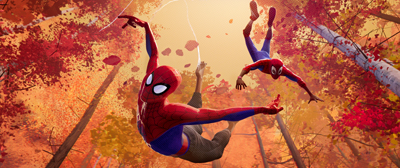 Pemberton wanted the film score to be a major part of Miles' world. A scene in which he is spray painting and listening to record scratching off Uncle Aaron's boombox had a big impact on his approach. He explains, "The score really has three elements " the electronics, the turntable and the orchestra. When I was somewhat younger, I used to spend a lot of time going to clubs and listening to scratch DJs. I'd always really been interested in record scratching and the turntable " which really is the cornerstone of hip-hop music " being used in a way that is musical rather than just for looping beats. Suddenly, it felt like I could take that world as it was the world that miles has submerged himself in " and use it as an integral part of what I was trying to do. Hip hop was often about remixing previous art forms into something new and I felt we were doing that with every aspect of this film."
Pemberton wanted the film score to be a major part of Miles' world. A scene in which he is spray painting and listening to record scratching off Uncle Aaron's boombox had a big impact on his approach. He explains, "The score really has three elements " the electronics, the turntable and the orchestra. When I was somewhat younger, I used to spend a lot of time going to clubs and listening to scratch DJs. I'd always really been interested in record scratching and the turntable " which really is the cornerstone of hip-hop music " being used in a way that is musical rather than just for looping beats. Suddenly, it felt like I could take that world as it was the world that miles has submerged himself in " and use it as an integral part of what I was trying to do. Hip hop was often about remixing previous art forms into something new and I felt we were doing that with every aspect of this film." To match the movie's eye-popping visuals, Pemberton took a complicated and ambitious route. Initially, he and his team recorded and mixed a variety of elements " anything from synthesizers to full orchestra " and then did the modern equivalent of outputting them onto vinyl, re-scratching them into the mix and then edited and remixed the track until they had something he was happy with. "I got a DMC World Scratch champion DJ to scratch all the parts in," he adds. "He said in all his time he'd never heard of anyone trying anything like this, so it was very exciting to be doing something that felt like the first time it was done. Sometimes we would play scenes and try and get the turntables and scratching to react as minutely and nimbly to what was happening on screen as you would an 80-piece orchestra. By the time we finished, it was really satisfying knowing we'd got a score that pulled everything from a high-concept sonic world, a sound palette that reflected the life of the character and also had a tune you could whistle. Every superhero needs a tune you can whistle."
Pemberton says he went out on a limb to incorporate new techniques to keep up with the movie's innovative visual panache. "Miles' theme, which you hear through the film as well as the very end of the picture,) is a hybrid of so many things," he notes. "We've got the sound of an actual aerosol spray can being scratched providing the hi-hat energy, we've got the electronic sounds I had designed for the spider bits being scratched to give this weird rising energy and then we've re-scratched in elements of the huge 80+ piece orchestral parts I'd written as well. Then, around this we have the other electronics, percussion and orchestral elements as well. It was ridiculously complicated, but it needed to sound effortlessly straight forward!"
Producer Phil Lord says he wanted the film's soundtrack to reflect the kind of tracks Miles would listen to in his normal life before his life changes forever. In addition to Pemberton's innovative music, the soundtrack also features new songs by some of today's biggest names in hip hop, pop, rock and Latin music. Among the top tracks are Post Malone & Swae Lee's blockbuster hit song "Sunflower," Nicki Minaj & Anuel AA featuring Bantu's "Familia," and Blackway & Black Caviar's "What's Up Danger." Republic Records, in collaboration with Sony Pictures, will release the soundtrack on December 14, 2018.
Spider-Man: Into The Spider-Verse
Release Date: December 13th, 2018
MORE




